During the coronavirus pandemic, there’s been a lot of interest in using germicidal lamps to disinfect surfaces rather than hosing everything down with bleach or disinfectant. Lamps are a little easier to work with when you’ve got things like knobs, buttons, and slider controls on test instruments that may not do well when doused with liquids.
There are two kinds of germicidal lights available. One is the traditional kind that uses low-pressure lamps that are similar to a fluorescent lamp. The second uses LEDs that put out light of about same wavelength, near 253 nm, in what’s called the ultraviolet C or UV-C light range.
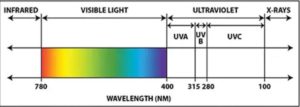
But there have been reports that a lot of the germicidal lights based on LEDs are actually fake, putting out light in some other range other than UV-C. Unfortunately, it generally takes a special light meter to check out whether or not a light source is putting out UVC light, and that kind of light meter tends to be a little expensive, particularly as the pandemic continues. Fortunately, we’ve got one.
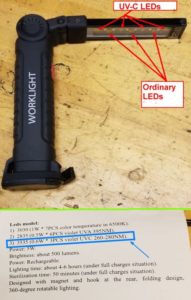
So we did a little test. We went online and bought two germicidal lights, one based on a conventional low-pressure tube, the other which used LEDs. We more or less picked both of these products at random. Then we checked them for UV-C output. One good thing about checking for UV-C light output is that ordinary fluorescent lights don’t put out any light in those wavelengths. So we were able to check for UV-C light output without turning off our room lights.
The UV-C lamp we bought online is advertised as putting out 7 W. It gave us a reading on our UV-C light meter in the range of about 500 μW/cm2 holding the lamp less than a foot away. (We didn’t really care about the exact output level because we were mainly just trying ascertain that our source actually does, indeed, emit UV-C.)
Next we went to the LED-based UV-C device. This particular device contains two different kinds of LEDs, one set emitting regular light, the other, presumably, emitting UV-C. The two kinds of lights are turned on
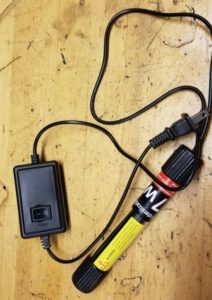
separately via a button on the handle. When we turned on the UV-C LEDs and held them less than a foot away from our UV-C meter, the output was so low that it was down in the noise for the most sensitive range of our UV-C meter, which handles full-scale readings of 200 μW/cm2.
This result prompted a second look at the small “user manual” for the LED UV-C light. The light had been advertised online as being a 5-W light. A close examination of the manual, however, revealed the UV-C part of the output was only 0.6 W. With an output this low, the light probably isn’t disinfecting anything. This is also sad news to buyers in that the LED UV-C light in our experiment cost us about $30, a little less than double what the ordinary UV-C lamp set us back.
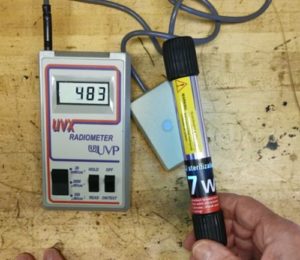
Because longer-wavelength UV light has been in the headlines recently, we decided to check our LED source for output at UV-A and UV-B wavelengths which run between 400 and 280 nm. Fortunately, light meters sensitive to those ranges cost less than those able to register UV-C. But our results were the same — the LED source puts out essentially zero at these wavelengths.
The moral of the story here is if you’re trying to get a germicidal light, you are probably better off getting a low-pressure lamp source. If you are getting a UV-C light based on LEDs it is really a case of buyer beware.

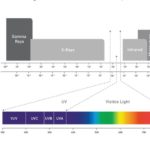
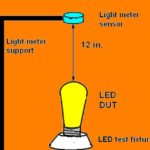

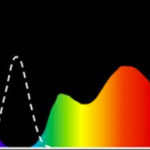

Ahhh that ‘splains it. I bought several for background enhancement. When Powered all I saw of course was the “white” light. As pointed out very little UV to enhance colors.
These weren’t even from our Asian friend but from US company that lobbied Congress to ban 100 watt incandescent lamps
This is great stuff! I unfortunately bought a bunch online and believe they’re fakes now. Any chance i can mail them to you for a test ?? That’d save a lot of headaches wondering!
Thank you,
Best regards!
J Welk, please DO NOT try to use UV-C for entertainment lights. UV-C is dangerous and will cause cataracts, blindness and cancer if powerful enough.
Black lights for making florescent colors glow are much lower frequency (longer wavelength) UV-A and therefore lower energy. Even those have some safety issues. High levels of UV-A cause skin cancer by damaging the DNA of skin cells.
Please do some study into the safe use of these. Blindness is REALLY bad. Causing it would be troublesome for those with a conscience.
You might try the method outlined here to check your lights:
https://www.nutsvolts.com/magazine/article/uv-sanitizer-how-to-build-one-and-measure-its-efficacy
It’s a simple DIY and doesn’t require a UV-C light meter.
Jeff Chan, yes, and it’s already happened https://hongkongfp.com/2017/10/26/partygoers-left-burns-light-sensitivity-hypebeast-event-landmark/
Party goers burned by UV-C lighting at a party.
Try wrapping some insulation tape around a green Banana. If UVC light is emitted the part under the tape will stay green and the rest will ripen slightly, depending on the strength and endurance of exposure.